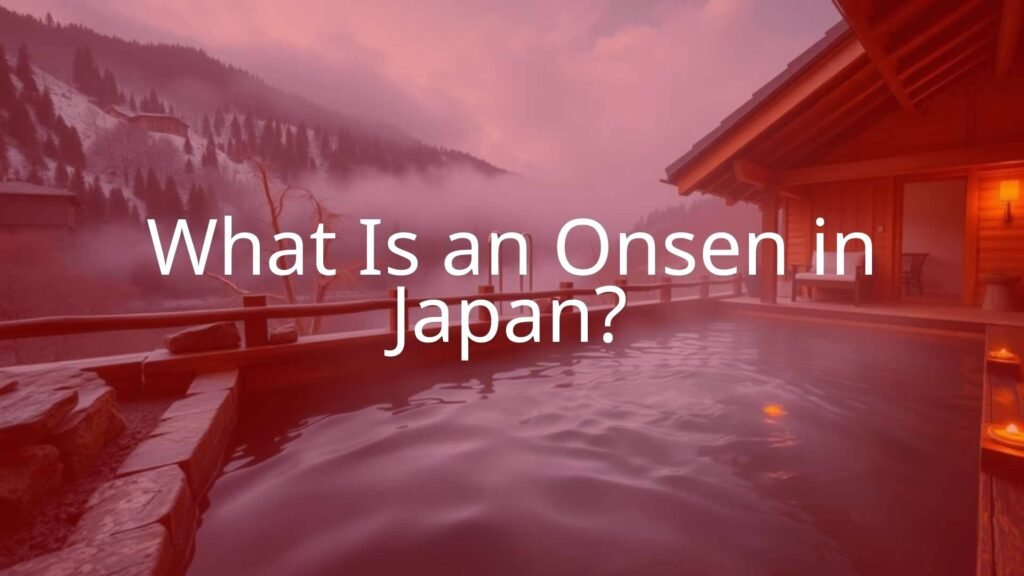An onsen, which literally means “hot spring” in Japanese, refers to both geothermally heated spring water and the bathhouses or inns (ryokan) that surround them. Onsens are an important part of Japanese culture, offering a relaxing and healing experience shaped by many generations of tradition. These bathhouses can be anything from simple outdoor pools in quiet mountain settings to fancy, modern resorts. They all use the natural hot water from Japan’s active volcanic zones to promote health and relaxation.

What is an Onsen in Japan?
What Does Onsen Mean?
An onsen is a place where hot water heated by underground volcanic activity comes up to the surface. The word “onsen” can mean both the spring itself and the facilities around it. Some onsen are just public baths, while others are full resorts with places to stay, multiple baths, and rooms for relaxing. These places let visitors rest and recover from both body and mind tiredness.
Japanese law-specifically the Hot Springs Act-says what counts as a real onsen. This law helps make sure onsens are genuine and keeps up good standards, so you can tell them apart from regular public baths. On maps and road signs, onsens are marked by symbols like ♨, the kanji 湯 (yu), or the hiragana ゆ (yu), all showing “hot water” and welcoming people to stop by.

Where Does Onsen Water Come From?
Japan has many volcanoes, which is why it has so many hot springs. There are about 25,000 natural hot spring sources and around 3,000 onsen businesses using this water. In every part of Japan, you can find onsen towns, making them a familiar part of local life.
The water in onsens is heated naturally below the earth and picks up different minerals on its way up. This not only makes the water warm but also gives it different colors, smells, and supposed health effects, depending on the minerals it contains.
What Makes an Onsen Official?
The Japanese government uses strict rules to decide what can be called an onsen. The water must either be at least 25°C (77°F) when it is collected or must have a certain amount of at least one of 19 listed minerals like sulfur, sodium, iron, or magnesium, even if the temperature is lower. There are also rules excluding certain natural gases.
- Water temperature at least 25°C (77°F) at the source
- Or, if cooler, must contain certain amounts of special minerals
These standards make sure the water is real hot spring water and that guests get the benefits expected from a proper onsen. If a place doesn’t meet these standards, it can’t claim official health benefits, and its use as a “hot spring” is limited.
How Did Onsen Culture Start in Japan?
Early History
The story of onsens goes back at least 1,300 years. Old records say Japanese Emperors and high-ranking families often visited hot springs for long periods. In the past, people believed these springs could heal many diseases-there are even ancient books claiming onsens could cure 40,000 types of illness! The tradition of staying at an onsen for health, called tōji, began very early.
Onsens were often built near Buddhist temples, showing how bathing was tied to both spiritual and physical cleansing. Some of the very first Japanese history books, like the “Kojiki,” mention onsens and their importance to Japanese society all the way back in the 8th century.
Onsens and Japanese Life
Over the centuries, onsens became popular not just for spiritual or medical reasons but also as places for people to come together, get clean, and relax. In the Edo period, they started appearing in art, and their popularity spread to ordinary people. Group bathing created a feeling of community, and still today, visiting an onsen town is a favorite getaway for people of all ages. Onsens help people unwind, recover from stress, and spend peaceful time alone or with friends. They continue to play a big role in Japanese life as places to heal and connect with others.

What Kinds of Onsens Are There?
Indoor and Outdoor Onsens
Japanese onsens can be found inside buildings or out in nature. Outdoor baths-called roten-buro-are especially treasured because they let you relax surrounded by beautiful views of rivers, mountains, or gardens. Many people enjoy bathing outside in winter, where the hot water and falling snow create a striking combination.
Indoor onsens, or uchiyu, are common in hotels and ryokan. These offer protection from bad weather and often have stylish features like wood or stone decor. Some facilities offer both indoor and outdoor options, letting you pick whichever atmosphere suits you best.
Public, Private, and Mixed Onsens
There are several ways onsens are set up:
- Public baths: Run by local towns; anyone can use them for a small fee.
- Private baths: Run by hotels or traditional inns, often only for guests.
- Private rental baths: Called kashikiri onsen or family baths (kazokuburo), can be used alone or with family.
In the past, men and women usually shared the same bath. Nowadays, most onsen have separate times or separate baths for men and women. The areas are clearly labeled, and colors on the curtains (blue for men, red for women) help people find the right side. If privacy is especially important, or if you want to bathe with family or as a couple, private baths can be reserved. Mixed-gender bathing is rare and usually found only in very remote or special types of baths where everyone wears swimsuits.
Different Types of Onsen Water
Onsens get their variety from the minerals dissolved in their water. Each type has its own supposed health benefits. Here are some of the most common:
| Type | Main Minerals | Believed Benefits |
|---|---|---|
| Sulfur | Sulfur | Skin diseases, blood pressure, diabetes |
| Sodium Chloride | Salt | Helps with wounds and hydration |
| Hydrogen Carbonate | Carbon dioxide | Circulation, smooth skin |
| Iron | Iron | Good for anemia, blood pressure, menstrual health |
| Acidic | Acids | Helps with skin issues, sensitive skin |
| Radioactive | Radon (low-level) | Supposed to help with blood pressure, gout, and pain |
| Simple | Low mineral | Gentle, good for sensitive skin, better sleep |

Some special types, like aluminum or sulfate springs, help with skin problems or digestion. In a few places, the water is safe to drink and claimed to help with certain health conditions. This range means there is likely an onsen with water that matches most people’s interests or needs.
What Are the Pros and Cons of Using an Onsen?
Why are Onsens Good for You?
Onsen bathing is known for making people feel relaxed and refreshed. The warm water and minerals can help sore muscles, improve blood flow, brighten skin, and provide relief from fatigue and some aches. Many Japanese people visit onsens regularly for these benefits.
- Lower blood pressure
- Better circulation and heart health
- Smoother, healthier skin
- Less muscle pain
- Better sleep and stress reduction
For tourists and locals alike, the onsen is a great way to recover after a long journey or hard day.
Possible Risks and Who Should Be Careful
Most people can use onsens safely, but there are a few things to know. If you have high blood pressure or heart problems, check with a doctor first-the heat can be tough on the heart. People with open wounds shouldn’t bathe, and pregnant women or people with other health issues should be careful.
There have been rare reports of bacteria causing problems in onsens with poor cleaning. Sanitation rules are now stricter as a result, and most big onsens are safe. To avoid problems, always wash first and never put your head under the water. Some places use a little chlorine, but many onsens rely on daily cleaning and fresh water. For everyone’s safety, good manners and cleanliness are important. There have also been rare incidents involving bad behavior, so privacy rules are strict in many places.
How Should You Behave at an Onsen?
Good manners are very important at an onsen. Following these simple rules keeps the bath clean and enjoyable for all guests.
Washing Before Bathing
Always wash thoroughly before getting in the water. Showers are found just before the baths; sit on a stool and wash with soap and shampoo (usually supplied). Rinse off all products before entering the hot spring. This makes sure the shared water stays clean for everyone else.
Bathing Without Clothes
Almost all traditional onsens require guests to bathe with no clothes-not even swimsuits. This is a deep-rooted tradition. To avoid embarrassment, remember that everyone is used to it, and nobody pays much attention to others. If you find this hard, look for baths with cloudy water or rent a private bath.
Rules for Towels and Personal Items
Guests get (or rent) two towels: a large one for drying off (which stays in the changing room) and a small one for modesty or light wiping in the bathing area. Never bring any towel into the water itself-it’s considered unclean. Many people put the small towel on their head or leave it on the side of the bath. Take off jewelry to avoid stains from minerals, and keep toiletries for the shower area, not the bath itself.
Tattoos
In Japan, tattoos have a bad image because of their link to organized crime. Many onsens ban visible tattoos, but some are now allowing foreigners to cover small tattoos with patches or use private baths. Always check the rules before you visit. Some towns are known to allow tattoos, and private rental baths are a good solution for those with larger tattoos.
Being Quiet and Respectful
Onsens are places to relax, so keep noise down and avoid splashing. Do not swim or dunk your head under the water. If you have long hair, tie it up so it doesn’t touch the water. Most people come to unwind, so keep talking quiet and try to keep things calm for others.
How to Make the Most of Your Onsen Visit
A visit to an onsen is more than just a bath-it’s a way to let go of stress and enjoy deep relaxation. Here’s what you can expect:
Getting Ready and Changing Rooms
When you arrive, take off your shoes and put them in a locker or on a rack. Pay the entrance fee at the counter or a ticket machine. Find the changing area for your gender-look for blue curtains or “男” for men, red curtains or “女” for women. Put all your clothing, including underwear, and your big towel in a basket or locker. Only take your small towel to the bath area.
Bathing Steps
- Go to the shower area and sit on a stool.
- Wash very well with the soap and shampoo provided; rinse off completely.
- Test the water first; some onsen baths are very hot.
- Enter the main bath slowly and quietly, bringing only your small towel (but never put it in the water).
- Soak, relax, and don’t rush. If it gets too hot, get out and cool on the side.
- Enjoy the peaceful setting-no loud talking or splashing.

After You Bathe
After you finish, most people like to leave the minerals on their skin-they are thought to be good for you. Pat yourself dry with your small towel, then dry off thoroughly with your large towel back in the changing room. Many facilities have hair dryers, lotions, or massage chairs.
Try a bottle of milk or an “onsen egg,” cooked in the hot spring, as a tasty end to your experience. If staying overnight, take time to explore the inn or just rest. The goal is to keep the relaxed feeling as long as possible.
What Should First-Time Visitors Know?
Going to an onsen for the first time might seem confusing, but it can quickly become a favorite memory if you follow a few tips.
Beginner Advice
- Go with an open mind. Communal nudity is normal and not embarrassing in Japan.
- To avoid crowds or feel more private, go early or late in the day, or choose a bath with cloudy water.
- Private baths can be booked if you want full privacy or are worried about tattoos.
- Always wash before soaking and keep your towel out of the water.
- Check tattoo policies before you go.
- Take your time; don’t rush through the experience.
Common Questions
- Onsens are not just hot tubs. The difference is the natural, mineral-laden water.
- People may wonder about cleanliness, but strict washing rules and fresh flowing water keep onsens clean.
- No set time for how long to stay-listen to your body and get out if you feel too warm.
- Not all onsens are the same-each has different water, style, and setting. Look for one that matches what you want.
- Language isn’t a big problem, since manners are shown by what others do. Watching others will usually tell you what to do.
Where and When to Find the Best Onsens in Japan
Famous Onsen Towns
- Hakone Onsen (near Tokyo) – Great views of Mt. Fuji
- Kusatsu Onsen (Kanto region) – Known for strong, acidic waters
- Noboribetsu Onsen (Hokkaido) – Dramatic scenery and many mineral types
- Nyuto Onsenkyo (Akita) – Old ryokan in forests, milky-white water
- Beppu Onsen (Kyushu) – Biggest supply of hot spring water, has colorful “Hells”
- Kurokawa Onsen (Kyushu) – Small, traditional onsen town by a river
- Ibusuki Onsen (Kagoshima) – Unique sand baths where you’re buried in warm sand
- Arima Onsen (Kobe) – One of the oldest and most well-known onsens
- Dogo Onsen (Ehime) – Old, beautiful bathhouse; inspired “Spirited Away”
- Fukiage Roten-no-yu (Hokkaido) – Forest bath, natural and mixed gender
- Jigokudani Monkey Park (Nagano) – Watch monkeys bathe in hot springs in winter
Best Time to Go
- Winter (Dec-Feb): Enjoy outdoor baths surrounded by snow for a beautiful experience. Many festivals during this time.
- Spring (Mar-May): Cherry blossoms make for lovely, scenic baths. Can be a busy season.
- Summer (Jun-Aug): Good for cooler mountain regions or onsen with cool baths.
- Autumn (Sep-Nov): Best for bright fall leaves; the colors around the onsen are stunning.
Prices and crowds are lower in late winter and early autumn, while holidays like Golden Week, Obon, and New Year are busiest and most expensive. Plan ahead to get the experience you want, and you’ll find an onsen visit can be a highlight of any trip to Japan.
- What Is a Maiko? - July 13, 2025
- What Does Domo Arigato Mean? - July 12, 2025
- What Does Naruto Mean? - July 12, 2025









